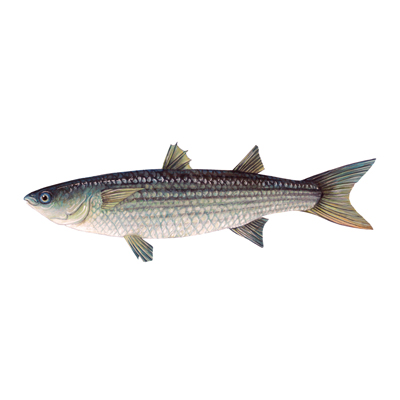

Mullet are plump silvery fish with large scales and flat wide mouths. There are three main species found in Cornish waters which can be hard to identify. They prefer coastal and estuarine habitats and can often be seen swimming lazily close to the surface in harbours and marinas.
Grey mullet are slow growing and late to mature and are classed as a medium resilience species (Fishbase), little is known about stocks around the Cornish coast although they can be abundant in some areas, (particularly estuaries). Anglers groups are concerned that stocks may be declining but there is little local evidence. Ban on all gill netting in estuaries (Cornwall IFCA) brought in in 2017 has helped protect mullet. Mullet are difficult to catch on rod and line and are important for recreational angling. Traditional beach seining targets mullet (usually golden grey mullet) and is a low impact method but occasionally will result in large catches flooding markets, resulting in prices falling.
5.5 tonnes of Grey mullet were landed to Cornish ports in 2021 with a value of £19.7k (MMO data).
Updated July2023
Cornish vessels landing to Cornish Ports
Gill nets are used to target mullet in coastal areas.
Learn moreCornish waters
Beach seine netting is a traditional technique occasionally carried out in sandy bays all around Cornwall by teams of fishermen working from small boats.
Learn moreCornwall Good Seafood Guide rates fish on sustainability using a scale of 1 to 5.
1, 2 and 3 are recommended, Fish to avoid are rated 5.
We use the system devised by the Marine Conservation Society (MCS) so our scores are comparable with the scores produced by MCS for the UK and fisheries from all around the world. For more information on scoring click here.
Mullet are caught by anglers on hook and line, by spearfishermen and commercially they are caught by beach seine nets and gill nets. The National Mullet Club report that off the Manacles (on the Lizard Peninsula) mullet have been caught by fishermen using a technique called 'ripping' where fish are foul hooked deliberately by fishermen drawing feathers through large shoals of mullet that are aggregating to spawn. Cornwall Inshore Fisheries and Conservation Authority report that as far as they are aware this is not a method that is being used at present.
Vulnerability and over exploitation of grey mullet in UK waters (Angling trust) 2018
Rass - Grey Mullet in the North Sea and English Channel
J. Pitcher and D. Pauly, 2005. A fuzzy logic expert system to estimate intrinsic extinction vulnerabilities of marine fishes to fishing. Biol. Conserv. 124:97-111 (source www.fishbase.org)
Cheung, W.W.L., T.www.fishonline.org
MMO landings data to Cornish ports.






Cornwall Good Seafood Guide is underpinned by the Marine Conservation Society (MCS) Good Fish Guide. The first UK consumer guide to sustainable seafood. For more information visit www.fishonline.org
Cornwall Good Seafood Guide is here to help us all make sustainable seafood choices. Choices that will help us keep the oceans healthy and Cornish fishers' futures safe. This website is funded by Cornwall Wildlife Trust. If you would like to make a meaningful difference to the health of our oceans, please consider making a donation to the Cornwall Wildlife Trust Ocean Emergency fund. Your donation will help safeguard these remarkable environments, ensuring that they continue to thrive for generations to come. Together, we can be stewards of the seas and champions for a healthier, more sustainable future.